-
Table of Contents
- How Do Navy SEALs Train for Underwater Combat Scenarios
- The Importance of Underwater Combat Training
- Key Components of Underwater Training
- 1. Physical Conditioning
- 2. Technical Skills
- 3. Mental Resilience
- Advanced Techniques and Equipment
- 1. Use of Rebreathers
- 2.
. Underwater Demolition
- 3. Case Study: Operation Neptune Spear
- Conclusion
How Do Navy SEALs Train for Underwater Combat Scenarios
The Navy SEALs, known for their elite status within the U.S. military, undergo rigorous training to prepare for a variety of combat scenarios, including underwater operations. This specialized training is crucial, as many missions require stealth and precision in aquatic environments. In this article, we will explore the training methods, techniques, and equipment that Navy SEALs utilize to excel in underwater combat.
The Importance of Underwater Combat Training
Underwater combat training is essential for Navy SEALs for several reasons:
- Stealth Operations: Many missions require SEALs to infiltrate enemy territory undetected, making underwater skills vital.
- Versatility: SEALs must be prepared for various environments, including rivers, lakes, and oceans.
- Survival Skills: Training prepares SEALs to handle emergencies, such as equipment failure or unexpected encounters.
Key Components of Underwater Training
Navy SEAL training for underwater combat is multifaceted, incorporating physical conditioning, technical skills, and mental resilience. Here are some key components:
1. Physical Conditioning
Physical fitness is the foundation of all SEAL training. Underwater combat requires exceptional strength, endurance, and flexibility. SEALs engage in:
- Swimming Drills: Long-distance swims and sprints to build cardiovascular endurance.
- Resistance Training: Weightlifting and bodyweight exercises to enhance muscle strength.
- Breath-Holding Exercises: Techniques to increase lung capacity and improve underwater endurance.
2. Technical Skills
SEALs must master various technical skills to operate effectively underwater. This includes:
- SCUBA Diving: SEALs are trained in SCUBA techniques, including the use of tanks and rebreathers.
- Combat Swimmer Techniques: Skills for moving stealthily through water, including finning and surface swimming.
- Navigation: Using underwater navigation tools and techniques to orient themselves in aquatic environments.
3. Mental Resilience
Underwater combat can be psychologically taxing. SEALs undergo training to develop mental toughness through:
- Stress Inoculation: Simulated high-stress scenarios to prepare for real-life situations.
- Teamwork Exercises: Building trust and communication skills among team members.
- Survival Training: Learning to remain calm and make decisions under pressure.
Advanced Techniques and Equipment
In addition to foundational training, Navy SEALs utilize advanced techniques and specialized equipment for underwater operations:
1. Use of Rebreathers
Rebreathers allow SEALs to remain submerged for extended periods without producing bubbles, which can reveal their position. This technology is crucial for stealth missions.
2. Underwater Demolition
SEALs are trained in underwater demolition techniques, which involve:
- Placement of Explosives: Learning how to effectively place and detonate explosives underwater.
- Reconnaissance: Conducting underwater reconnaissance to gather intelligence on enemy positions.
3. Case Study: Operation Neptune Spear
One of the most notable examples of Navy SEALs’ underwater capabilities was during Operation Neptune Spear, the mission that led to the death of Osama bin Laden. SEAL Team Six utilized advanced diving techniques and stealth to approach the target undetected, showcasing the effectiveness of their underwater training.
Conclusion
Navy SEALs undergo extensive training for underwater combat scenarios, focusing on physical conditioning, technical skills, and mental resilience. Their ability to operate effectively in aquatic environments is supported by advanced techniques and specialized equipment, such as rebreathers and underwater demolition skills. The rigorous training ensures that SEALs are prepared for the challenges they may face during missions, ultimately contributing to their reputation as one of the most elite fighting forces in the world.
For more information on Navy SEAL training, you can visit the official U.S. Navy website at Navy SEALs.





